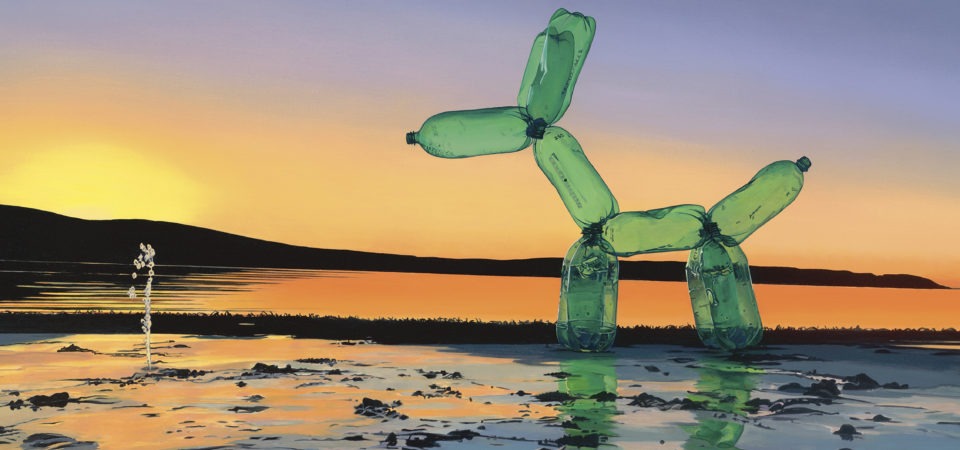Before the Covid-19 virus hit the US here at its epicenter in Washington State, I had been secluded at home for almost a year while grieving the sudden death of my husband of thirty-six years. I was having difficulty leaving the house or engaging my creative self to make paintings.
When pandemic stay-at-home lockdowns started to roll out in March 2020, I had just begun to find my sea legs – venturing into my studio, onto the beach, beyond my house, and into new personal and creative relationships. Forced to stay put again challenged my tenuous footing.
But as it turned out, the Covid stay-at-home restrictions were a remarkable and surprising gift to me. I was greatly comforted as the collective community joined me in seclusion, all of us pausing together in place to reinvent our separate lives while untethered from worldly expectations. I felt as if the universe had kindly slowed down, allowing time for a gentle reassembly of my broken heart, and given me a reprieve from the pressure to function in society.
Staying at home, being outdoors while working and playing, has given us all time and opportunity to commune directly with nature, to observe first-hand the fauna and flora close by around us. With fewer people traveling, we’ve enjoyed hearing the songs of birds more clearly because of the reduced noise and pollution from cars and planes. Could the pandemic, even with all its drawbacks, be contributing to a more profound friendship with nature, encouraging a better understanding and appreciation for animals and plants? In a sort of viral transformation, could social distancing outside be giving us a nudge away from consumer habits and towards protecting wild animal habitats within our orbits? Might we learn from the full-alert
response we’ve had to the disease of the Covid-19 virus and apply it to a healing transformation of the viral dis-ease of our earth’s ecosystems?
As for myself, I continue to address the issue of viral plastic trash in my subversively light-hearted yet serious paintings and drawings on the subject of ocean degradation. Come-Covid-hell-or-high-water, it is possible to find me regularly combing the beaches of Discovery Bay, not looking for shells or natural forms, as I am most interested in the rubbish, the objects we purposefully ignore and discard. Taking them back to my studio, I monumentalize the collected debris in my large-scale oil paintings. By placing the familiar and disposable in new contexts, I hope to lead my viewers to consider consumer culture’s cost on our environment. Imbued with humor, my work aims to avoid the didactic tone of many politically engaged artworks. Plastic bottles transform themselves into fantastic primordial creatures, and dinosaurs jostle with toy soldiers, with unexpected wordplay in titles that encourage delving back into the paintings.
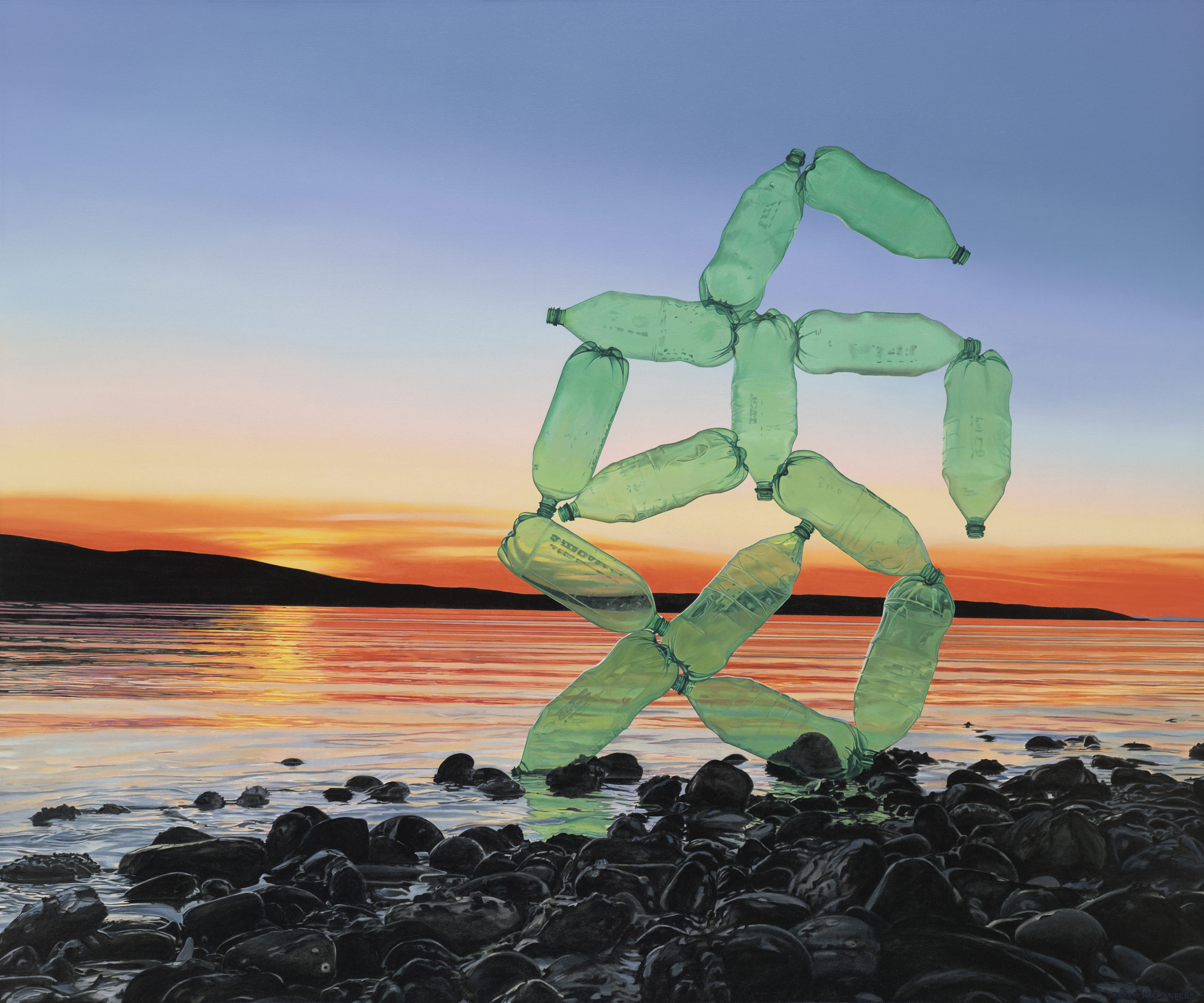
Theory of Evolution
oil on canvas
60 x 72 inches
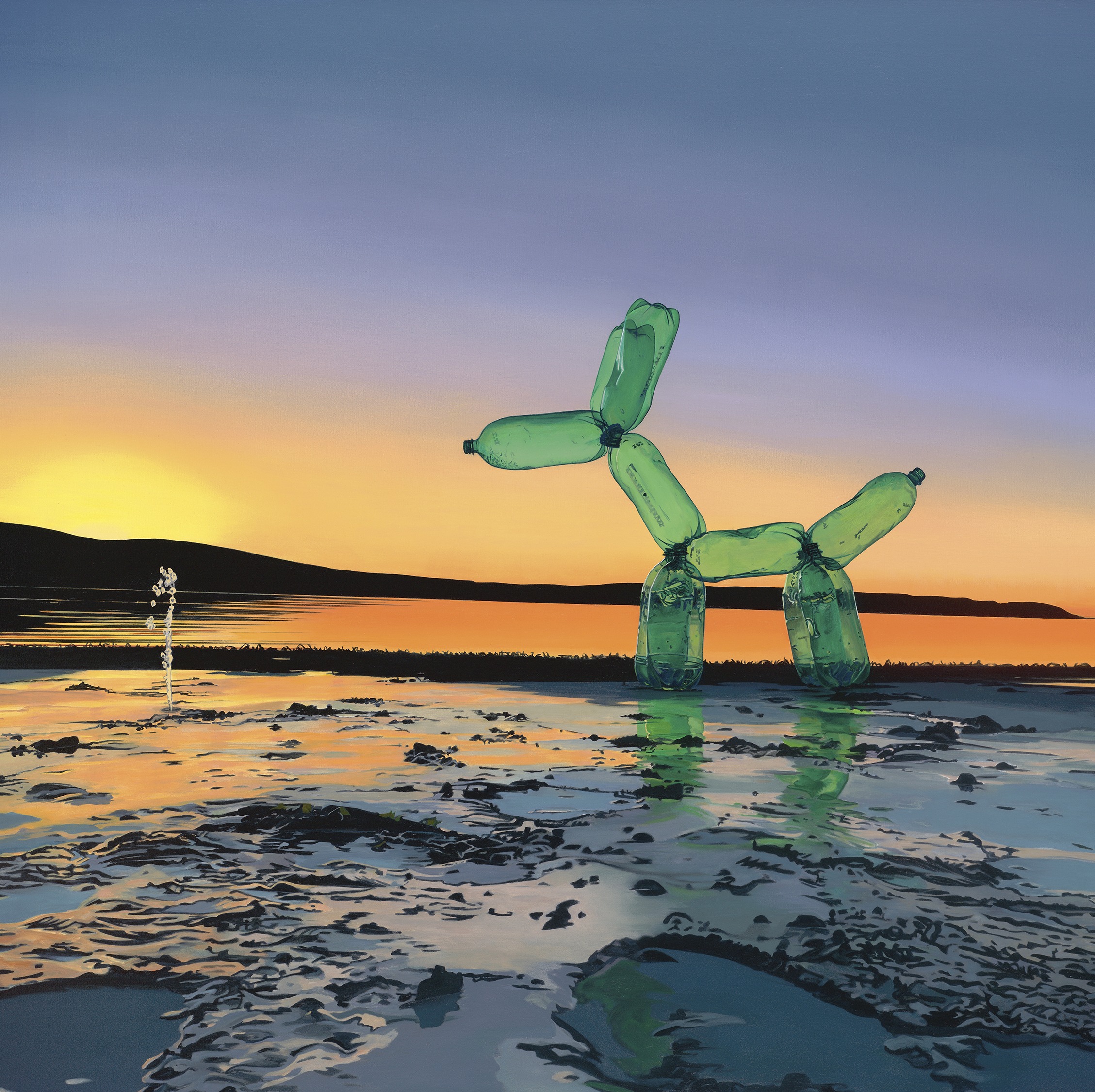
Primordial PETE
oil on canvas
54 x 74 inches
In my latest large-scale paintings made during the Covid-19 pandemic, now on view at Patricia Rovzar Gallery in Seattle, I riff on the ideas of 19th Century naturalist Charles Darwin. My painting of a plastic bottle-dog, Primordial PETE, steps out of the primordial ooze of the Plasticene Era to troll Jeff Koons. For this series, I assemble discarded green PETE plastic bottles to create models of post-apocalyptic sea creatures that I imagine evolving from the toxic soup of plastics and chemicals we humans have dumped into our oceans. I pose and photograph these models on the beach below my studio and use my photos as a reference to paint intuitive compositions and cultural narratives. Through this therapeutic sand-play, I highlight our destructive human foibles’ obliviousness in stories set against a beautiful yet deteriorating natural world.

Karen in the studio painting Primordial PETE
Another of my pandemic paintings, The New Colossus in the Sea Stack series, ironically refers to Emma Lazarus’s poem written for the Statue of Liberty in 1903, a poem that has become synonymous with the mythic American ideal of embracing all comers to our shores. The painting echoes the current tearing-down of repressive historic public monuments and national border closings due to pandemic and immigration policies. It is a visual play on Lazarus’s words, a stacked plastic tower made from the “tempest-tost” toy “refuse” “teeming on our shore,” standing on the beach to greet travelers and immigrants as a poor substitute for the welcoming grace of Lady Liberty.
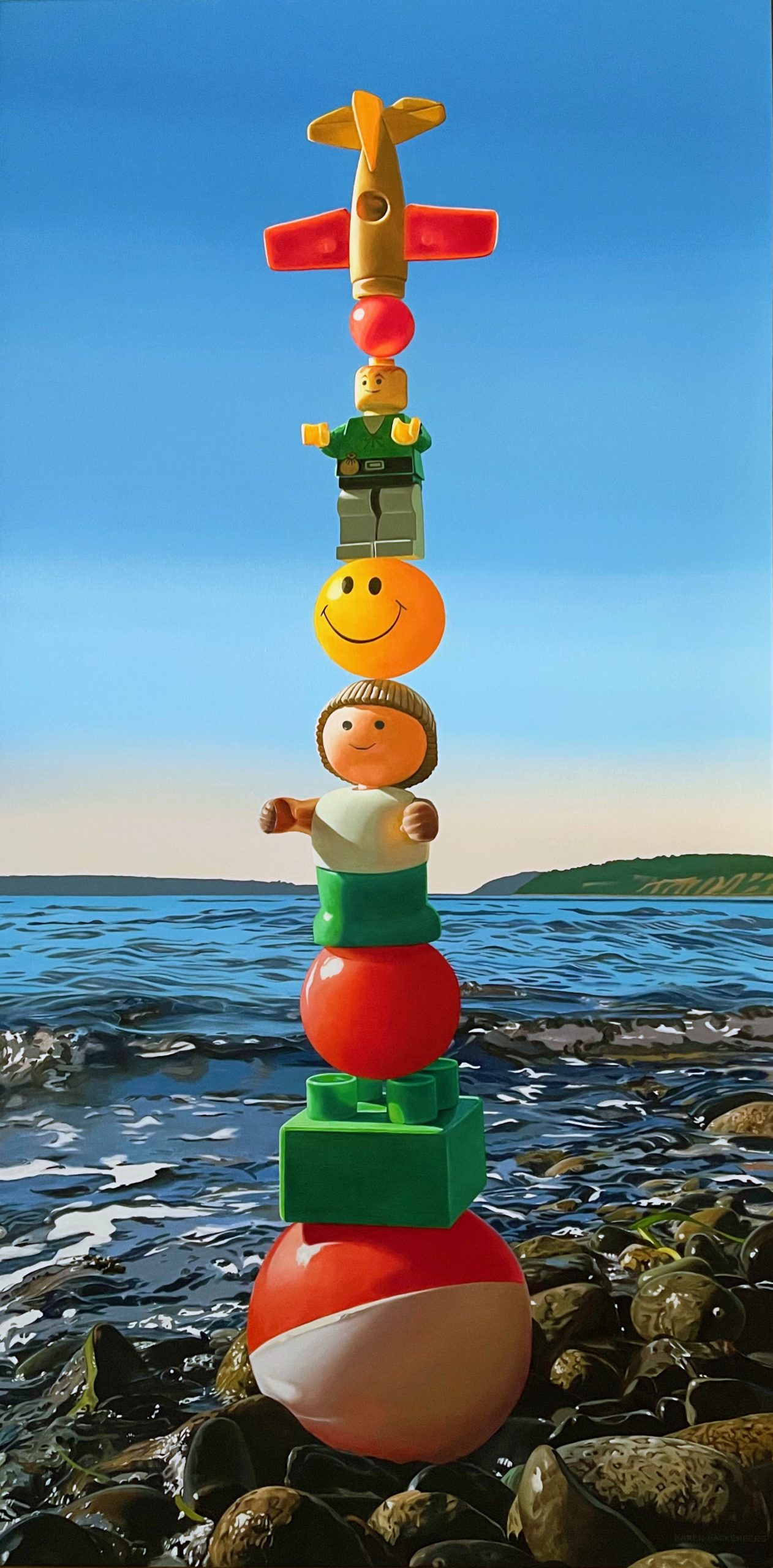
The New Colossus
oil on canvas
72 x 36 inches
“Give me your tired, your poor,
Your huddled masses
yearning to breathe free,
The wretched refuse
of your teeming shore.
Send these, the homeless,
tempest-tost to me,
I lift my lamp beside
the golden door!”
From the poem The New Colossus by Emma Lazarus
The viral spread of ocean plastic that lands on our shores provides an endless supply of visual inspiration for my paintings. Making this work has oddly helped counteract my angst about habitat degradation, enriched and kept me afloat in dire times, and engendered hope that my ironic humor can encourage action in favor of our fellow creatures.
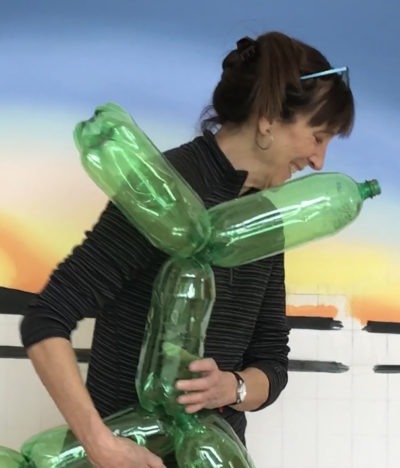 Karen Hackenberg
Karen Hackenberg
Represented by Patricia Rovzar Gallery, Seattle
Karen Hackenberg received her BFA in painting from Rhode Island School of Design, moved west to live for a decade and a half in San Francisco, and now lives and works near Seattle, WA.
For her ongoing painting series, she finds inspiration in the incongruous human-made detritus that washes up on the otherwise pristine beach below her studio – plastic shards, plastic bottles, plastic toy animals, shotgun shells, and product packages, to name a few. Pop Art of the 1960s has influenced her work– Claes Oldenburg’s monumental everyday objects and Ed Ruscha’s paintings combining marketing graphics with nature images.
Tacoma Art Museum has invited her to participate in the 2023 NW Perspectives series at Tacoma Art Museum in a solo exhibition as a foremost regional artist.
TAM’s Rock Hushka, and Juan-Roselione, curator of the Rubell Family Collection, Miami, recently chose her work for the special exhibition Northwest Art Now at the Tacoma Art Museum.
Hackenberg’s museum exhibitions also include a solo exhibition at Bainbridge Island Museum of Art; the international traveling show, Environmental Impact II; Neo-Naturalists at Museum of Northwest Art; Stilleven: Contemporary Still Life at Hallie Ford Museum of Art; and Beneath the Surface: Rediscovering a World Worth Conserving at AAAS headquarters, Washington DC.
Her green sensibility has earned a place in numerous private and public collections, including the New York State Museum, NY, the Portland Art Museum, OR, the Tacoma Art Museum, WA, the Washington State Art Collection, Bainbridge Island Museum of Art, WA, and the Hallie Ford Museum of Art, OR.
The notable art magazines, LoDown in Berlin, Germany, and BlackBook in Brooklyn, New York, currently feature her work.
A studio interview with Hackenberg, Fine Art from Beach Trash, was recently recorded and aired on King 5 Evening TV and is now available online.
Website
Instagram: @karenhackenberg
Twitter: @karenhackenberg
Facebook: Karen Hackenberg Studio
Linkedin: Karen Hackenberg.
Patricia Rovzar Gallery.
Book for sale.
King 5 Evening TV, Fine art from beach trash.
This article is part of the MAHB Arts Community‘s “Covid19 Diaries Series”. If you are an artist interested in sharing your thoughts and artwork, as it relates to the disrupted but defining period of time we live in, please contact Michele Guieu, Eco-Artist, MAHB Member, and MAHB Arts Community coordinator: micheleguieu@gmail.com. Thank you. ~

